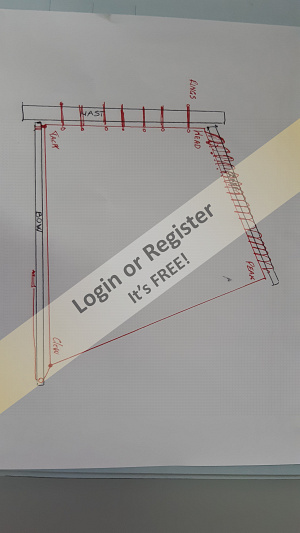Join Us On Social Media!
“Karoline” Dutch potato/fishing boat, billings boat kit, help please.
16 Posts · 9 Followers · 26 Photos · 97 Likes
Began 1 year ago by
Follow This Thread
Not currently following
> Click to follow
> Click to follow
Latest Post 12 months ago by
( Newest Posts Shown First )
📝 “Karoline” Dutch potato/fishing boat, billings boat kit, help please.
19 Views · 4 Likes
Country: 🇮🇹 Italy
Online: 10 hours ago
Online: 10 hours ago
Hi Rogal, I'm glad the images were helpful to you.
Don't worry too much about the text, it doesn't matter if you don't translate it.
I'll send you more images as soon as I can.
Don't worry too much about the text, it doesn't matter if you don't translate it.
I'll send you more images as soon as I can.
▲
⟩⟩
Len1
Rogal118
hermank
jumpugly
📝 “Karoline” Dutch potato/fishing boat, billings boat kit, help please.
32 Views · 5 Likes
Country: 🇬🇧 United Kingdom
Online: 3 days ago
Online: 3 days ago
Thankyou HermanK, for the info you have sent also. The actual Model Boat magazine originally released in August 2005. Was still available, i have ordered an original print and it will be delivered this week.So i will have my copy to read in full size, as and when required. Thankyou once again for your help, without it i would not have known about this magazine artical.
▲
⟩⟩
Len1
jumpugly
AlessandroSPQR
Mike Stoney
hermank
Roger
📝 “Karoline” Dutch potato/fishing boat, billings boat kit, help please.
32 Views · 5 Likes
Country: 🇬🇧 United Kingdom
Online: 3 days ago
Online: 3 days ago
Thankyou for the information Alessandro
SPQR. Very good, i cant read italian but the photos and drawings are very discriptive.these will help alot in the coming days as i intend to make the sails ready for rigging "Karoline".Thankyou once again.
SPQR. Very good, i cant read italian but the photos and drawings are very discriptive.these will help alot in the coming days as i intend to make the sails ready for rigging "Karoline".Thankyou once again.
▲
⟩⟩
Len1
jumpugly
AlessandroSPQR
Mike Stoney
hermank
Roger
📝 “Karoline” Dutch potato/fishing boat, billings boat kit, help please.
23 Views · 7 Likes
Country: 🇮🇹 Italy
Online: 10 hours ago
Online: 10 hours ago
📝 “Karoline” Dutch potato/fishing boat, billings boat kit, help please.
43 Views · 7 Likes
Country: 🇧🇪 Belgium
Online: 7 hours ago
Online: 7 hours ago
ROGAL 118
my friend is restauring this boat and has the sailplan. I will sent you a pm so you have my email. Can you sent me your adress details so i can sent a copy of the plan
regards
herman
my friend is restauring this boat and has the sailplan. I will sent you a pm so you have my email. Can you sent me your adress details so i can sent a copy of the plan
regards
herman
▲
⟩⟩
Mike Stoney
Len1
Razor1955
Peejay
Rogal118
jumpugly
AlessandroSPQR
📝 “Karoline” Dutch potato/fishing boat, billings boat kit, help please.
45 Views · 5 Likes
Country: 🇮🇹 Italy
Online: 10 hours ago
Online: 10 hours ago
Ciao Rogal.
Keep in mind that what I have described are only the fastenings of the sail to the mast, the boom and the gaff but they have not released to the real movement.
In an RC boat you can follow various methods to control the gaff sail.
I know three: the one I used (with a single sheet directly wrapped around the reel of the winch), the one RossM used of the double reel with two sheets (brilliant, very original, but for me a bit too complex in fact I discarded them at the time) and the most common one of the closed ring, a single sheet but not wrapped directly around the winch but attached to a rope that moves closed on itself thanks to the winch.
In any case they all move the boom and the sheets are attached to it.
Keep in mind that what I have described are only the fastenings of the sail to the mast, the boom and the gaff but they have not released to the real movement.
In an RC boat you can follow various methods to control the gaff sail.
I know three: the one I used (with a single sheet directly wrapped around the reel of the winch), the one RossM used of the double reel with two sheets (brilliant, very original, but for me a bit too complex in fact I discarded them at the time) and the most common one of the closed ring, a single sheet but not wrapped directly around the winch but attached to a rope that moves closed on itself thanks to the winch.
In any case they all move the boom and the sheets are attached to it.
▲
⟩⟩
Len1
Razor1955
Peejay
hermank
Rogal118
📝 “Karoline” Dutch potato/fishing boat, billings boat kit, help please.
54 Views · 6 Likes
Country: 🇬🇧 United Kingdom
Online: 3 days ago
Online: 3 days ago
Good afternoon AlessandroSPQR, thank you for the drawings they are very helpful in understanding the mechanics of the rigging etc. any info is most appreciated as this is all new to me, except for my building the IngaIV. This vessel seams a little simpler as only the mainsail boom is connected to the servo cord. So hopefully once I have an idea how the rigging works I can set about cutting and sewing the sails, with the correct fittings attached.




▲
⟩⟩
Mike Stoney
Len1
Razor1955
Peejay
hermank
AlessandroSPQR
Roger
📝 “Karoline” Dutch potato/fishing boat, billings boat kit, help please.
46 Views · 6 Likes
Country: 🇮🇹 Italy
Online: 10 hours ago
Online: 10 hours ago
The photo I posted in the previous message is just to show where the parts of the sail I mentioned are. Obviously it is not that type of boat, only the gaff sail is similar.
The photo below is a sketch made on the fly to illustrate the solution with the sail tied to the boom, fixed only on two points.
As already said in some boats the tie to the boom is done as for the gaff, that is a rope that passes through the eyelets on the side of the sail and the boom itself.

The photo below is a sketch made on the fly to illustrate the solution with the sail tied to the boom, fixed only on two points.
As already said in some boats the tie to the boom is done as for the gaff, that is a rope that passes through the eyelets on the side of the sail and the boom itself.

▲
⟩⟩
Mike Stoney
Razor1955
Peejay
hermank
Len1
Rogal118
📝 “Karoline” Dutch potato/fishing boat, billings boat kit, help please.
51 Views · 6 Likes
Country: 🇬🇧 United Kingdom
Online: 4 hours ago
Online: 4 hours ago
Looking at the model it is well worth the effort in restoring. Nicely built and should look great on the water.
Roy
Roy
▲
⟩⟩
Razor1955
Peejay
hermank
Len1
Rogal118
jumpugly
📝 “Karoline” Dutch potato/fishing boat, billings boat kit, help please.
46 Views · 6 Likes
Country: 🇮🇹 Italy
Online: 10 hours ago
Online: 10 hours ago
Sorry I can't help you with specifics because I don't have any drawings, photos or other information about this boat.
Typically this type of sail (the "gaff sail") has three lashing sides.
The side hoisted on the mast is tied with wooden hoops, like the ones RossM did with his Bluenoose (I suggest you look at his model because he did a great job). On this side some boats use a rope that goes through eyelets instead of wooden hoops. I preferred to use hoops on my schooner for several reasons.
The side of the sail that is fixed on the gaff is usually tied with a rope that goes through the eyelets of the sail itself. There are several ways to do this type of lashing, I followed one that was consistent with that period and type of ship. If you want I can send you two or three drawings with as many lashing options.
The side of the sail hoisted on the boom can have two different ways of lashing. It can have a binding along the entire boom with a rope that passes through the eyelets (present on the edge) or only two binding points. One point is located on the corner of the sail called “Tack” and the other on the opposite side, that is, on the corner of the sail called “Clew”. I chose the latter solution.
The advantage of having rings (on a real ship) is that of being able to easily lower the gaff on the boom without removing the sails.
The advantage of having only two attachment points on the boom makes it easier (on real ships) to mess with the gaff sails (that is, collecting the sail on the mast with special running maneuvers), in fact on the Clew the binding is not fixed to the boom but is regulated by a rope and a block (pulley) that can be released.
I hope to have time to collect some drawings this evening to better illustrate what I have written.

Typically this type of sail (the "gaff sail") has three lashing sides.
The side hoisted on the mast is tied with wooden hoops, like the ones RossM did with his Bluenoose (I suggest you look at his model because he did a great job). On this side some boats use a rope that goes through eyelets instead of wooden hoops. I preferred to use hoops on my schooner for several reasons.
The side of the sail that is fixed on the gaff is usually tied with a rope that goes through the eyelets of the sail itself. There are several ways to do this type of lashing, I followed one that was consistent with that period and type of ship. If you want I can send you two or three drawings with as many lashing options.
The side of the sail hoisted on the boom can have two different ways of lashing. It can have a binding along the entire boom with a rope that passes through the eyelets (present on the edge) or only two binding points. One point is located on the corner of the sail called “Tack” and the other on the opposite side, that is, on the corner of the sail called “Clew”. I chose the latter solution.
The advantage of having rings (on a real ship) is that of being able to easily lower the gaff on the boom without removing the sails.
The advantage of having only two attachment points on the boom makes it easier (on real ships) to mess with the gaff sails (that is, collecting the sail on the mast with special running maneuvers), in fact on the Clew the binding is not fixed to the boom but is regulated by a rope and a block (pulley) that can be released.
I hope to have time to collect some drawings this evening to better illustrate what I have written.

▲
⟩⟩
Razor1955
Peejay
Mike Stoney
Len1
Rogal118
jumpugly





 Captain
Captain United Kingdom
United Kingdom Fleet Admiral
Fleet Admiral Italy
Italy














 Rear Admiral
Rear Admiral Admiral
Admiral














